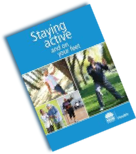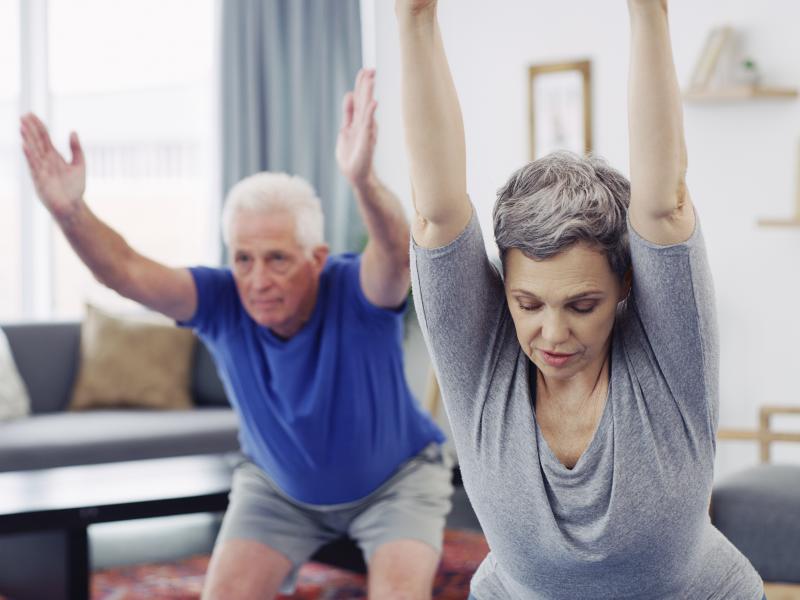
Preventing falls
Falls can be common, with 1 in 3 people over the age of 65 falling each year. A fall can lead to injury, loss of confidence and reduced independence.
But falls are not an inevitable part of getting older. Learning simple steps to improve your strength and balance can help you keep fit, active and reduce your risk of falling.
You can learn about preventing falls by completing our module on falls prevention or search the Active and Healthy directory to find a falls prevention program in your local area.
For a falls prevention program, look for programs with the “FP” falls prevention symbol. This means the program is designed to help reduce the risk of having a fall.
Our Staying Active and On Your Feet booklet is also full of ideas and information about ways to reduce your risk of falling. People living in NSW can get a free printed copy posted to them.
Ask your general practitioner (GP) or health professional if you need help with falls prevention.
Here are some ideas you might like to get started with:
Build your confidence
Build your confidence
About half of older adults are concerned about falling. You might fear falling if you’ve had a fall yourself, know someone who has, or feel less steady on your feet than you used to.
A fear of falling can be helpful as it may protect you from undertaking risky activities. However, if you are too worried about falling, you may be less confident in your ability to balance. This can cause you to be more cautious, which can increase your risk of falling and be harmful to your health and wellbeing.
A fear of falling can also affect your wellbeing if it stops you doing things you enjoy, such as walking, shopping or visiting friends. This can stop you getting the movement your joints and muscles need to stay healthy and keep you steady.
If you’re worried about falling when doing a certain activity, you could try:
- doing it the first few times with someone you trust – like a friend or family member -before doing it on your own
- thinking of ways to make the activity safer, such as putting a handrail in beside your bath
- asking for help.
If you don’t feel as confident on your feet anymore, there are still ways you can stay active. Learn more about getting started with physical activity in older adulthood.
Just remember, being more confident and less fearful can reduce your risk of falling.
Exercise to help you stay strong and steady
Exercise to help you stay strong and steady
As we get older, we tend to lose strength and balance. This can increase the risk of tripping over or having a fall.
Look for safe exercises which also get more challenging over time. For example, you could:
- do balance and strength exercises at home (such as these simple exercise circuits)
- join a local falls prevention or balance exercise class
- find a Tai Chi program in your area (Tai Chi has been shown to improve balance)
- try lawn bowls, croquet, Pilates or yoga.
For the best results to prevent falls, aim to do at least 2 hours of these types of exercises per week (or 20 minutes a day) for 6 months or more.
Make your home and surrounds safer
Make your home and surrounds safer
Most falls happen at home, so making your home as safe as possible can help reduce your risk of falling.
Some ways to do this include:
- removing things you could trip over, such as loose mats, rugs and clutter
- making sure you have good lighting, especially on stairs and at night
- installing railings and grab bars
- making sure your shoes fit well, are supportive, and have soles that aren’t slippery
- using a chair for bathing and making sure your toilet seat is high enough to get on and off easily
- making sure your floors aren’t slippery
- paying attention to what you’re doing and not rushing.
For more ways to make your surrounds safer, see our home safety checklist.
You can also learn how to get up after a fall.
Look after your health to lower falls risk
Look after your health to lower falls risk
Some health problems can make people more likely to have a fall. This includes health problems such as arthritis, stroke and diabetes. Some medicines can also increase your risk of falling.
You can use our checklist to see if your health or lifestyle may be affecting your risk of having a fall.
Here are some things you can do to help lower the chance of a health issue contributing to a fall.
Get your vision checked
As we get older, we might experience changes to our vision. We may not see as clearly. We also might be less able to judge distance and depth and adjust to sudden light changes. This can affect our ability to see the edges of steps and stairs.
Wearing bifocal, trifocal or multifocal glasses can also make a fall more likely.
You can help reduce your risk by:
- getting your eyes checked by an optometrist or ophthalmologist annually
- making sure you have good lighting in your home
- giving your eyes time to adjust to light changes, and when you get new glasses or have any eye treatments
- wearing sunglasses and a hat to reduce glare when outdoors
- getting a separate pair of glasses for walking outdoors.
You can learn more about how to keep your eyes healthy by completing our module on vision or by downloading our factsheet on vision.
Get your medications checked
Some prescription and over-the-counter medicines can increase your risk of falls. Some medications may make you feel drowsy, unsteady, dizzy or confused.
The medicines that make falls more likely may include those for:
- anxiety
- depression
- sleeping difficulties.
People who take four or more medicines a day are at particularly high risk of falling.
You can ask your doctor or pharmacist about how your medicines may be affecting your risk of falling.
Look after your feet
Healthy feet and well-fitted footwear help reduce your chances of tripping and falling.
As we get older, our feet can change shape and lose some feeling and flexibility. This can change the way we walk and affect our balance. You can help your feet stay healthy by keeping your toenails trimmed and getting treatment for bunions, corns and calluses.
See your doctor or a podiatrist if you have painful or swollen feet or need help to look after your feet.
The safest footwear has:
- thin firm soles with a tread
- low square heels
- a firm support around the heel.
Consider a walking aid
Using a walking aid (like a walking stick or walking frame) may help you to walk more easily and safely.
You can talk to a health professional such as a physiotherapist or occupational therapist about whether this might help you. They can help you get a walking aid that’s right for you and learn how to use it safely and confidently.
If you use a walking aid at home, you might need to rearrange your furniture so you can move around easily.



